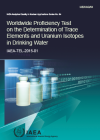Terrestrial environments are biodiverse and provide valuable ecosystem services. The IAEA uses nuclear and isotopic tools to study the impact and movement of pollutants in such environments, assisting Member States with risk assessments, environmental remediation, and planning for future industrial activities.
Land pollution
The full impact of human activity and pollutants is difficult to quantify. The movement of pollutants in the environment means that traces of contaminants can be found even in very remote locations. Radionuclides and hazardous substances, such as toxic trace elements, persistent organic compounds (including pesticides and industrial chemicals) and polycyclic aromatic hydrocarbons released from industrial, agricultural and mining activities potentially degrade the resilience of ecosystems and affect human health. At the same time, decision-makers and enforcement agencies often lack reliable data on the nature, extent and location of pollution problems.
Using nuclear techniques to monitor pollution
As part of its environmental protection initiatives, the IAEA assists its Member States with monitoring, modelling and assessments. The data gained from these activities can be used to inform management and policy decisions, such as the need for additional filtration systems or environmental remediation programmes.
A key service offered by the IAEA is training on environmental monitoring, which focuses on sampling and measurement techniques for air, water, soil and plants. This training is provided by the Agency’s environment laboratories. They study the concentration of various substances, for example uranium-238, arsenic and selenium, in water near uranium mines. They employ different nuclear techniques for such analyses, depending on the particular pollutant or matrix to be analysed. The concentrations in the samples can be used to determine whether the environment is adequately protected and to assess the impact of chemical exposure on humans and biota (living organisms).
Industrial activities, for example oil extraction, or the mining of natural resources, such as uranium, copper, lead and gold, are another potential source of pollution. These may produce harmful levels of concentration of natural radioactive elements, also known as Naturally Occurring Radioactive Materials (NORMs), while processes associated with the mining industry, such as milling, processing, and the storage of tailings, can cause serious pollution challenges if not managed properly. Industrial processes and legacy sites can cause long-term damage to ecosystems. The IAEA uses naturally-occurring isotopic tracers to identify sources, transport pathways and fluxes of pollutants so that better mitigation measures can be put in place and, where necessary, remedial action taken.
The IAEA also studies and monitors radionuclides in the environment and the pathways they take between soil, water, air, plants and animals. Understanding their behaviour in the environment helps estimate their distribution following accidental releases, for instance by nuclear installations. This provides decision-makers with the necessary information to better assess risks and potential impacts and to take steps toward remediation.
Analysing pollutants to support remediation
Before remediation activities can be implemented, the pollutants in question must be precisely identified and quantified. The IAEA develops and uses nuclear techniques for this very purpose. It also helps create models of contaminant fluxes and performs associated risk assessments. Once the contamination has been characterized, a remediation plan can be developed, which needs to include the selection of appropriate remediation strategies to minimise the long-term impact of contaminants on local and regional ecosystems.





